Welcome to one of the most active flamenco sites on the Internet. Guests can read most posts but if you want to participate click here to register.
This site is dedicated to the memory of Paco de Lucía, Ron Mitchell, Guy Williams, Linda Elvira, Philip John Lee, Craig Eros, Ben Woods, David Serva and Tom Blackshear who went ahead of us.
We receive 12,200 visitors a month from 200 countries and 1.7 million page impressions a year. To advertise on this site please contact us.
|

|
|
vertical string pull on the soundboard (torque)
|
You are logged in as Guest
|
|
Users viewing this topic: none
|
|
Login  | |
|

   
RobF
Posts: 1611
Joined: Aug. 24 2017

|
 RE: vertical string pull on the soun... (in reply to Armando) RE: vertical string pull on the soun... (in reply to Armando)
|
|
|
I don’t know if you could call having the information crucial or not, or else it would already be pretty common knowledge, I suppose, but you could probably arrive at a rough estimate empirically by measuring the vertical deflection of a top under load and then comparing the result with the deflection of a sample top of similar thickness and characteristics after it is loaded down with a known weight placed in the bridge area. The sample top would have to be braced in the same manner and supported along its edges, however, perhaps by a set of sides that have been bent. Heck, maybe it is common knowledge and I’ve just never came across it. My empirical method might be tainted if the deflection due to load isn’t a linear response, however, or maybe it’s better to say the results will only be only meaningful if the deflection remains in its linear region.
Actually, now that I think about it, it probably is easier just to ask one of the wizards on here to do the math, like you just did, lol. It might be as simple as multiplying the sum of the stated string tensions by the fraction defined by the string height above the top divided by the string length, but don’t know. Maybe Konstantin or Richard will step up to the plate and come up with something more meaningful. But, would you really need anything more than a ballpark figure?
P.S. I take it you are wanting to pre-calculate the top rise so you can work out neck angle, or maybe something along those lines (I’m still trying to figure out why this info is crucial). Some people will either simulate a load or actually string the guitar when setting up, and I guess that’s the most accurate way, as it includes neck rise and relief, which any formulae will also have to do. I just allow for a rise of approximately 0.2mm at the 12th, so I set the guitar up with lower action to account for that. But maybe that’s not why you want the the information.
|
|
|
|
REPORT THIS POST AS INAPPROPRIATE |
Date Jul. 19 2020 15:37:39
 |
|

   
TonyGonzales84
Posts: 78
Joined: Apr. 23 2020
From: San Diego, CA

|
 RE: vertical string pull on the soun... (in reply to Armando) RE: vertical string pull on the soun... (in reply to Armando)
|
|
|
Everybody in the water!
Note: I have edited and corrected my original response, to that shown here. I apologize if you have read my initial response and were confused by it; it would have been correct only in the case of an antique type of tie-block, prior to luthiers/guitarreros including a separate saddle.
Armando,
1) Statically, the net vertical load due to the strings can be calculated, first, by calculating the string turning angle, A. A is the Arc Tangent of the quotient of the difference in height that the saddle sits above the tie-block holes, a (a is the numerator), and the distance forward of the front end of the tie-block that the string turns down from the top of the saddle, b (b is the denominator): Arc Tangent (a/b) = A. (I apologize for not showing a sketch - I am not near a printer/scanner, nor do I currently have good sketching software.)
Next, take the sine of A and multiply it by the string tension F. F * sine A = Net Vertical Force. This force pushes down (against) the top.
2) The static torque applied to the top, by the strings via the saddle/bridge assembly, also causes vertical displacements of the top.
3) What type of simulation are you intending to perform? It's often a challenge to actually set up and perform a test that tests what you are attempting to test, and not a (possibly closely related) phenomenon.
The above is the Reader's Digest version. Hopefully, this is not the place where Mr. T comes in with his, "get ready for the pain!" Addressing each of the three, numbered points, in slightly expanded form:
1) The vertical load (against the top) changes when the strings are set into vibration, due to these vibration induced dynamic vertical loads. Richard Jernigan has linked an interesting and enlightening article by Alan Carruth, here (excellent work in investigating the dynamic vertical loads, etc):
http://alcarruthluthier.com/Downloads/stringTheory.pdf
The vertical loads are dynamically present as reactions to the strings's transverse (vertical) vibrations.
The static vertical loads, due to the torque caused by the strings, are a couple, reacted by the bridge, which then must be reacted by the top. The part away from the soundhole, which is trying to be pulled off, is exactly matched by the part towards the soundhole, which is being pressed into the top. The values of these static loads change during string vibration.
I recommend caution in attempting to simulate such dynamic loads, overlaid on the static load caused by the saddle turning angle, as static loads: this can be self-defeating, especially in regards to the actual physics and design/construction problems and possible solutions. Please refer to Mr. Carruth's paper for more discussion on the vertical loads.
2) The vertical displacements caused by the applied torque also affect the top in buckling, between the bridge and soundhole (I believe that, statically, it is (somewhat?) relieving), actually inducing a top buckling load on the other side of the bridge.
A guitar is a structure that is designed for (by) stiffness considerations, as apposed to a structure being designed by strength considerations. For example, the top probably doesn't want to be designed to buckle anywhere (although it might be interesting to some, to design and build a guitar (top?) lightly enough that it would be statically stable against buckling, but that might temporarily buckle in certain, well-understood dynamic modes); also, think of the pre-strung tone tuning performed by luthiers; in Mr. Carruth's paper, he discusses a 4 kHz mode of longitudinal string vibrations, that he recommends slightly lengthening the scale in order to avoid resonant effects caused by said modes. Designing for stiffness requires much finesse and attention to detail in, for example, local and minute structural deflections, and scares the hell out of many engineers!
As to one of the kernels in your original post, the static torque applied by the strings, calculated at the bridge-to-top joint is just the height of the strings, h, multiplied by the total force of the strings (can be looked up on several manufacturer's sites), F (the same F as discussed above). Remember here, that, the bridge and top also have to react (withstand) the longitudinal load of the strings, F: The bridge-to-top glue joint has to not fail due to this shear load, and the top, between the bridge and soundhole has to not buckle.
3) Rereading your original post, it seems you wish to apply a (static) vertical load to simulate the torque. I don't fully understand what one might gain from this test: it does not fully simulate a guitar, as a guitar actually functions. Much or all of the foregoing might go into planning a test that would simulate the way a guitar actually functions.
Best regards, and I look forward to hearing your thoughts!
Tony
_____________________________
Tony
|
|
|
|
REPORT THIS POST AS INAPPROPRIATE |
Date Jul. 19 2020 22:09:03
 |
|

   
RobF
Posts: 1611
Joined: Aug. 24 2017

|
 RE: vertical string pull on the soun... (in reply to Armando) RE: vertical string pull on the soun... (in reply to Armando)
|
|
|
quote:
I'm not really a math guy and would love to have just a tool where to enter the variables and the thing would spill out the result. The thing is that i'm not building nearly enough guitars to get it in my fingers when the stiffness of a top is just right
Here’s a way to do a deflection test, no math required. Matter of fact, the only numbers you really need are the deflection measurements themselves, which you will want to start to record for each guitar. The weight in the picture is arbitrary, although it wouldn’t hurt if it was something easy to replicate, such as 500g, 750g, or 1kg. But, honestly, it doesn’t matter as long as it stays constant. The measurements taken from one top to the next provide the points of reference.
Three pictures should be enough to tell the story. They should be regarded solely as an example of one way you can go about helping your fingers read a top. A lot of information can be derived from a measurement such as this. But the point is, you don’t need formulae, computer programs, or a degree in Engineering or English Literature to build a good guitar. Just let common sense rule the day.
I won’t go any deeper, this should get you started, and you can custom tailor the methodology and how you treat the data to suit your own needs. I hope this is of some help. Cheers!
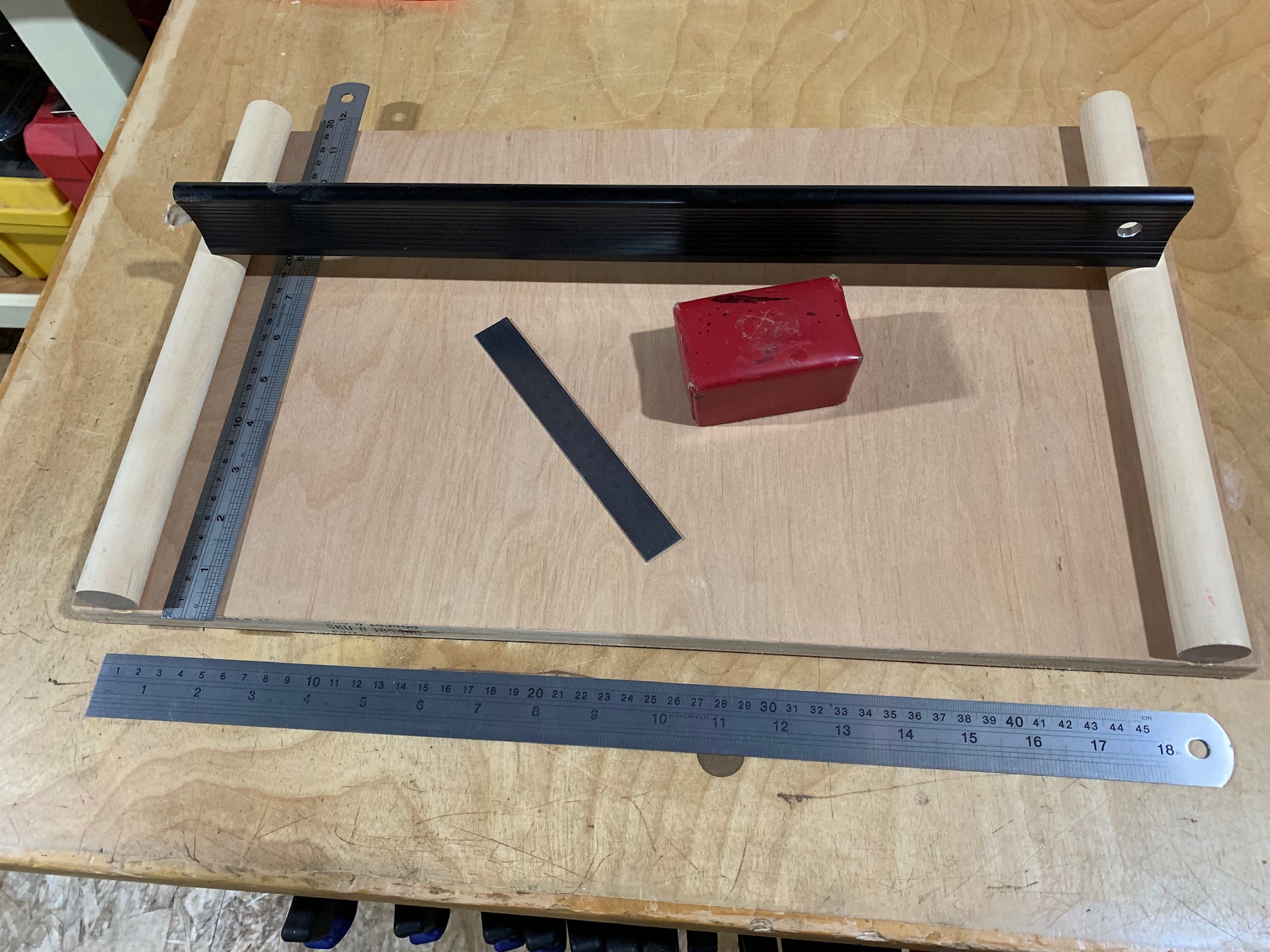
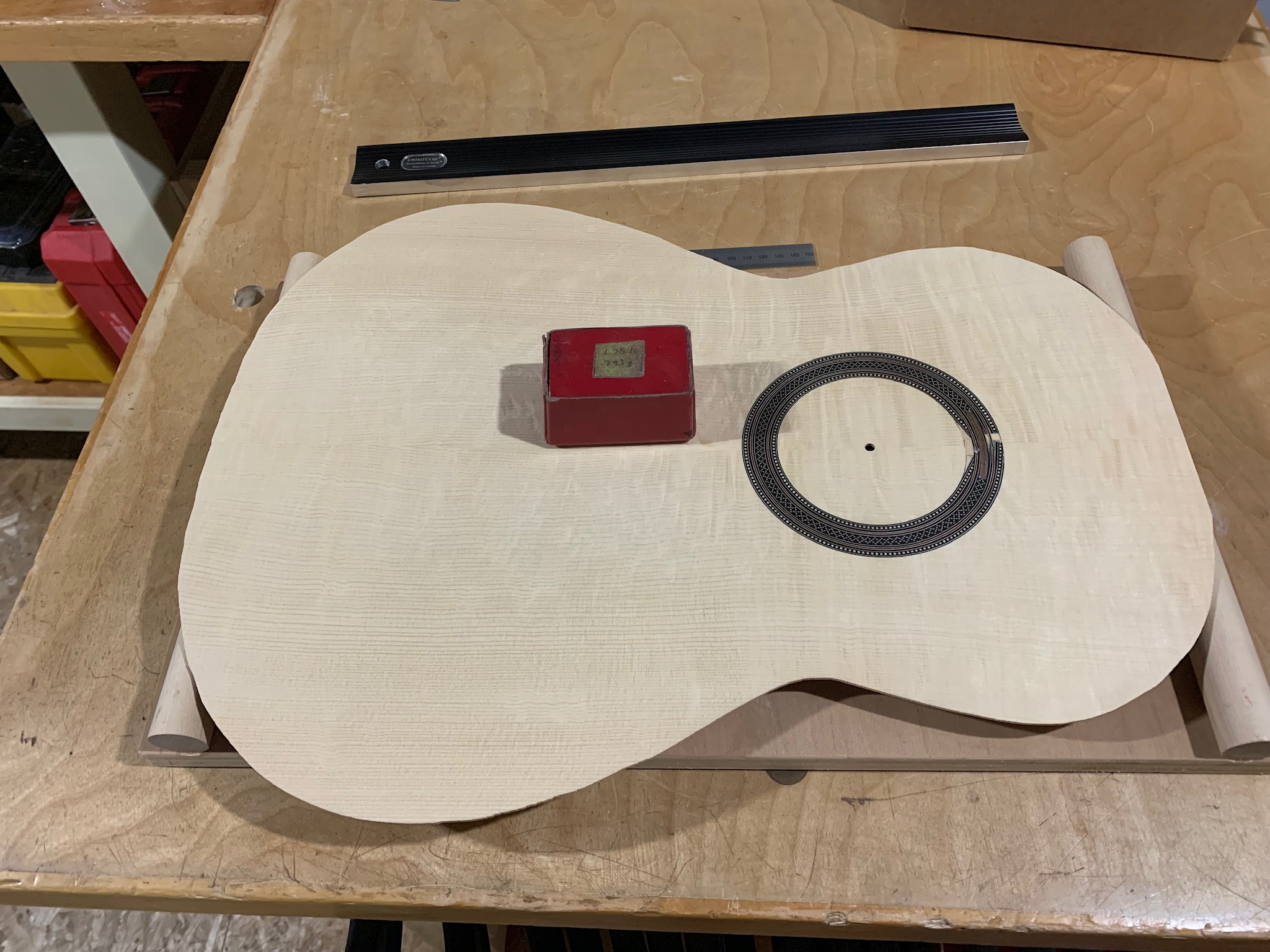
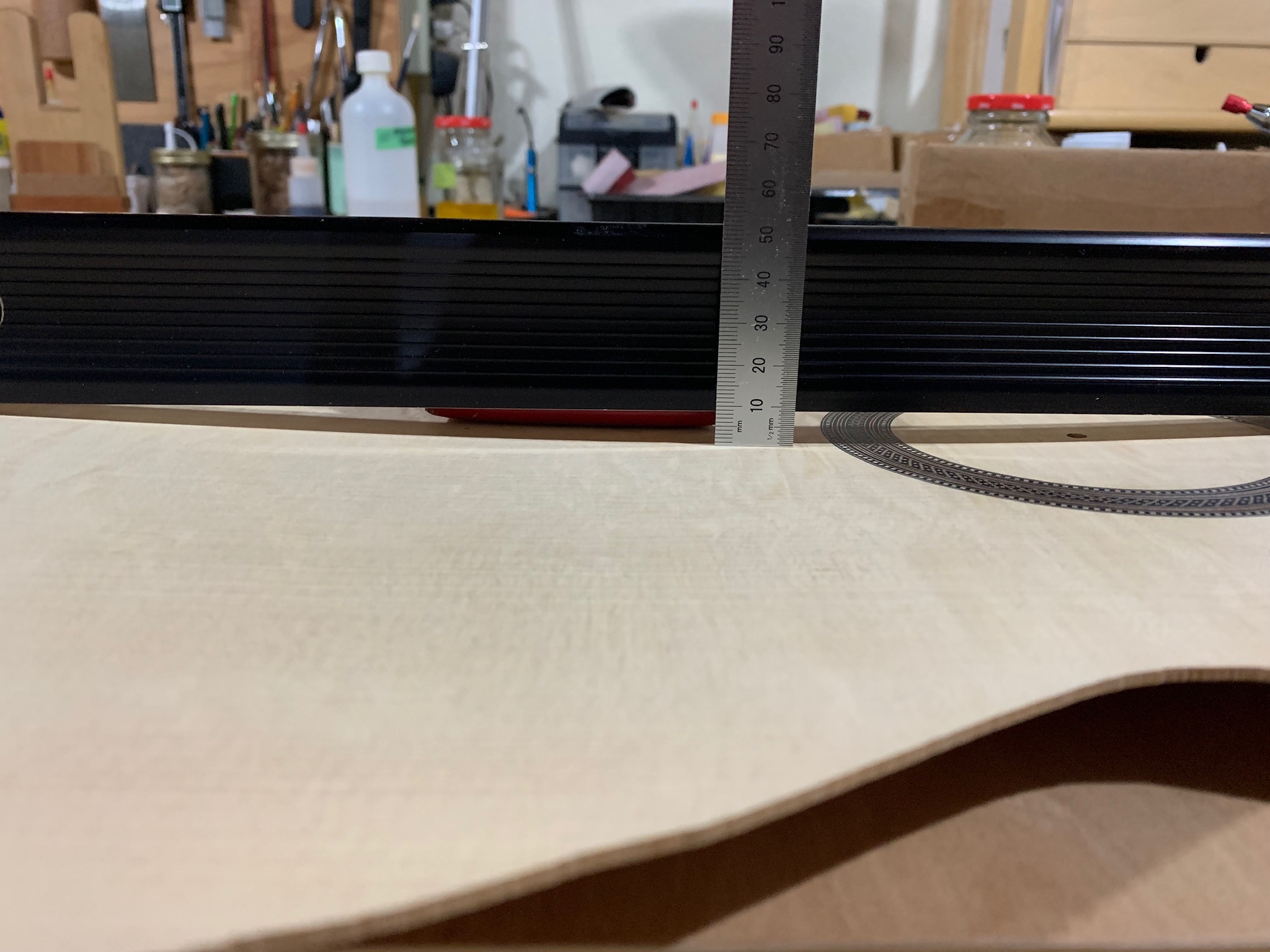
Images are resized automatically to a maximum width of 800px
 Attachment (3) Attachment (3)
|
|
|
|
REPORT THIS POST AS INAPPROPRIATE |
Date Jul. 28 2020 23:49:50
 |
|

   
estebanana
Posts: 9351
Joined: Oct. 16 2009

|
 RE: vertical string pull on the soun... (in reply to Armando) RE: vertical string pull on the soun... (in reply to Armando)
|
|
|
Long scale - don’t fart around with 650 scales anymore. Make flamencos with 26” and over scales 665 mm - don’t cater to the new world whiners who think their precious hands will be destroyed with higher tension. Tell the snivelers to use a cejilla in the first fret until they can play the open scale. Take no prisoners, do not give in.
Long string lengths drive the top better. The important part is the strength along the grain, if your tops are too stiff along the grain sand along the grain a bit before you glue the bridge on.
Long scale, use five braces and focus them under the bridge and leave the bouts open. Stiffness aling the grain, medium bridge weight, not too light, definitely not too heavy. About 20 grams with a longer scale. Stiffness along the grain is more important for activating the modes that generate the upper frequencies that are pertinent to good tone and projection. The open unbraced lower bouts encourage the side to side teeter totter movement of the cross di pole mode, that mode combo gives flamenco guitars a lot of substantive tone, the growly husky sound is partially developed by a slightly over active cross dipole.
Restriction to the full unidirectional movement of the bridge by a stiff top along the grain will redirect the bridge movement to the loosest direction. If the bridge can’t move as much in the center axis toward the neck and tail, some of that energy will be picked up and redirected into the cross pole direction.
Think of the top like a crucifix- the vertical beam is the long mono pole or stiffness along the grain, the cross bar is the cross di pole axis and literally the bridge. Keep the long beam stiff and allow the cross beam to flap like bird’s wings.
Too stiff along the grain? Can’t figure it out? Use three strong central braces under the bridge and two slighter braces at the outer edges of the bridge. ( look At Brune’s 1951 Barbero drawing) then use a long scale 660 and longer up to 665mm
And to reiterate the most important point, slap the idiots who want short scales unless they show up with a note from a doctor saying they are clinically dead.
_____________________________
https://www.stephenfaulkguitars.com
|
|
|
|
REPORT THIS POST AS INAPPROPRIATE |
Date Aug. 7 2020 2:16:11
 |
|

  
ernandez R
Posts: 737
Joined: Mar. 25 2019
From: Alaska USA

|
 RE: vertical string pull on the soun... (in reply to Armando) RE: vertical string pull on the soun... (in reply to Armando)
|
|
|
Stu & Stephen
My last two builds both are 666mm built concurrently with the tops sliced off next to each other and all other woods cut from the same pieces accordingly.
Couple observations. One is my best, well rounded with a good low end grawl and nice trebles. This one the top lifted the usual amount under tension.
The other is a beast. A whole different magnitude better. After about six months strung up and a fair amount of playing, both still in the white cause I still can't get in the shop yet with my buggered up foot, i notice I've got about 5mm at the 12 fret. Hmm. I spend some time thinking about how the neck could have moved that much... still under some pain meds and mind **** nerve blockers. After I kick the pill habits I notice the neck is mostly were it was all along. The top had lifted a lot. She might end up in the wood stove... Then again I might get medieval with her, slice the neck off leaving the fretboard connected, then reattach accordingly...
So now I'm wondering, was the top too thin, the braces too thin, plenty of other variables and I'm not much of a note taker... What is the variable that made her so much better then her sister?
Less then ten guitars in and thinking one can use all the math and measuring tools out there and one still needs to build a hundred guitars using the same mold and woods etc like the old masters to get the feel for where one needs to aim to get an output. I don't know, failing for the words.
Need to add that I'm not using a standard bracing but a radial system half copied and half the product of my mind...
HR
_____________________________
I prefer my flamenco guitar spicy,
doesn't have to be fast,
should have some meat on the bones,
can be raw or well done,
as long as it doesn't sound like it's turning green on an elevator floor.
www.instagram.com/threeriversguitars
|
|
|
|
REPORT THIS POST AS INAPPROPRIATE |
Date Aug. 8 2020 19:51:34
 |
|

   
estebanana
Posts: 9351
Joined: Oct. 16 2009

|
 RE: vertical string pull on the soun... (in reply to JasonM) RE: vertical string pull on the soun... (in reply to JasonM)
|
|
|
It works both ways, because guitars are mysterious animals.
Some tops dip in front of the bridge and some don’t and still work. Use a ruler in front of the bridge and behind the bridge to get a reading. Sometimes what looks arched is flat in front and slightly arched behind- in the space of an wide bridge.
There are many iterations to how the top to bridge area gets sculpted due to string pull vs. top strength along the grain and bridge flexibility. Just because a thin top characteristically tends to dish in between the bridge and sound hole does not mean that it’s the only sculpture of the top that is working.
Dished tops are a three edged sword. 1. It’s light and high performance in one sense. 2. It’s like a Amodovar film, on the verge of a nervous breakdown. 3. It may or may not be squishy in that dished area. If the dish is happening and the area is ‘hard’ and the braces are sectioning off the area and allowing it to be depressed, but still hard and stiff it’s going to function better in the way string energy will activate higher frequency modes in that region. The B flat trough D# on the high E string. A lot of that support in those frequencies comes in part from that region between the bridge and sound hole. If that area is dished but still stiff enough it’s good. If it got sculpted into that dished shape because the stiffness along the grain is _much too weak_ then trouble.
There’s a line between dished out in front of bridge, but still functioning, and dished but too weak. Where that line develops from a practice standpoint is difficult to determine, it’s a fine line.
The Redgate model classical guitar with lattice bracing, or whatever he throws in there, is predicated in the idea that the top is light and thin and will be sculpted into that dished shape. So the intention was to allow a thin top to be braced to mold it into that wave shape, but make it super stiff. It seems to work. It’s a good one to think about as a thought experiment, but you wouldn’t get a very flamenco sounding guitar if you build it as he builds that wave model. He told a friend of mine he’d rather build flamenco guitars, but he makes a good living building guitars that sound like Bosendorfer pianos.
Condes’ characteristically have a different zeitgeist- slightly heavier bridge and top, fairly long scale and often no braces in the lower bout between the bridge and the outside rim of the top. They have a different tempo of attack than a guitar with dished out top. But all that is subtle subjective stuff that needs to be parsed out one guitar at a time. But conde guitars generally work in the principal that you don’t want the top to sculpt into a wave along the grain.
Here’s what can typically happen to the Conde approach, the top dishes between the edge of the bridge arm and the side of the lower bout. If you hold a straight edge across the top behind the bridge, you’ll see a slight arc where the seam of the bridge meets the top and then it (may or may not ) dip into a slight valley between bridge and edge of guitar. If you exaggerated that line it would look like swell with a shallow trough on either side.
Some guitar tops hold an arch in every direction, the peak of of the dome usually under the bridge. And some guitars express a wave shape that can be oriented either across the grain or with the grain. If the wave is expressed along the grain it looks like a bulge behind the bridge and a dish in front of the bridge. If expressed across the grain it usually looks like the bridge is in a hill with slight troughs on either side.
All these expressions of stress work or are tolerable to the guitar and it will function, be stable and sound good. But there is a fine line to when these expressed sculpted Stresses become liabilities. Safe to build the guitar that holds an arch in every direction and eventually through the course of your building practice make forays into the wave shape styles or intentions.
_____________________________
https://www.stephenfaulkguitars.com
|
|
|
|
REPORT THIS POST AS INAPPROPRIATE |
Date Aug. 10 2020 3:09:57
 |
|
 New Messages New Messages |
 No New Messages No New Messages |
 Hot Topic w/ New Messages Hot Topic w/ New Messages |
 Hot Topic w/o New Messages Hot Topic w/o New Messages |
 Locked w/ New Messages Locked w/ New Messages |
 Locked w/o New Messages Locked w/o New Messages |
|
 Post New Thread
Post New Thread
 Reply to Message
Reply to Message
 Post New Poll
Post New Poll
 Submit Vote
Submit Vote
 Delete My Own Post
Delete My Own Post
 Delete My Own Thread
Delete My Own Thread
 Rate Posts
Rate Posts
|
|
|
Forum Software powered by ASP Playground Advanced Edition 2.0.5
Copyright © 2000 - 2003 ASPPlayground.NET |
0.125 secs.
|


 Printable Version
Printable Version



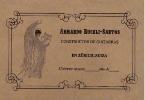

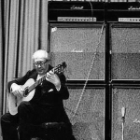
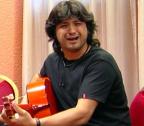


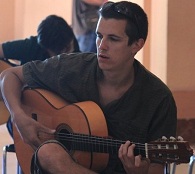





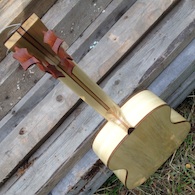

 New Messages
New Messages No New Messages
No New Messages Hot Topic w/ New Messages
Hot Topic w/ New Messages Hot Topic w/o New Messages
Hot Topic w/o New Messages Locked w/ New Messages
Locked w/ New Messages Locked w/o New Messages
Locked w/o New Messages Post New Thread
Post New Thread